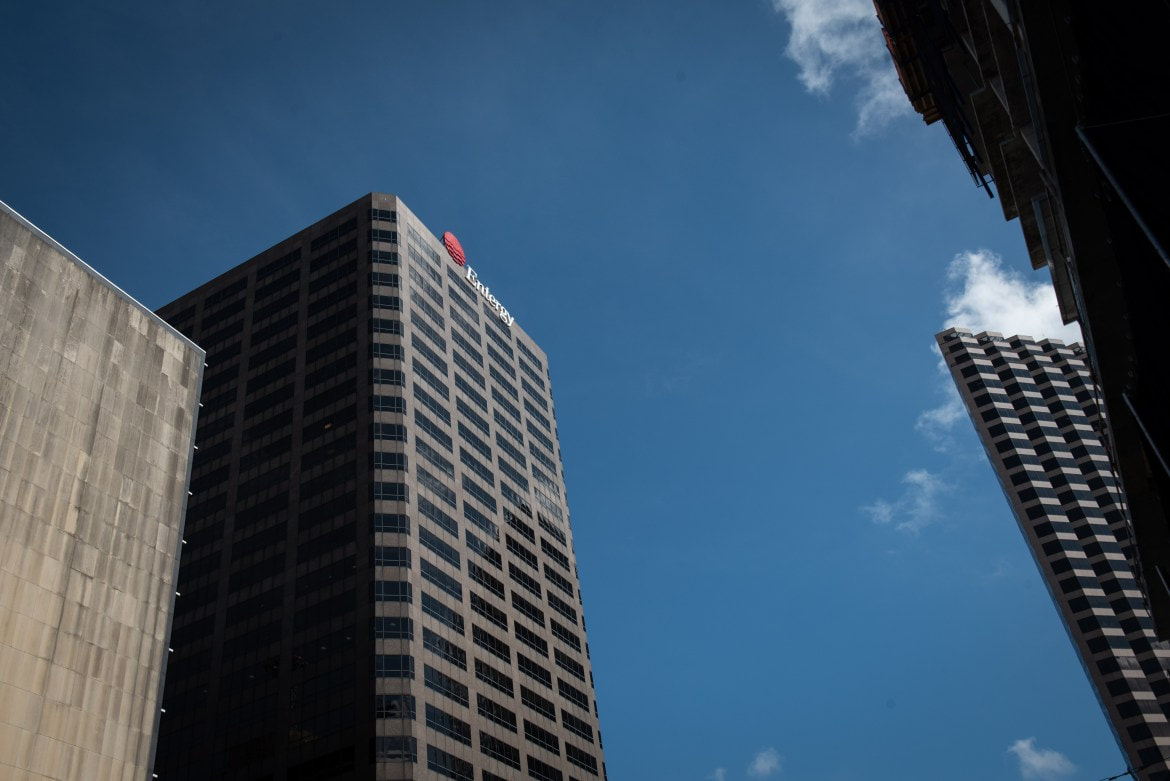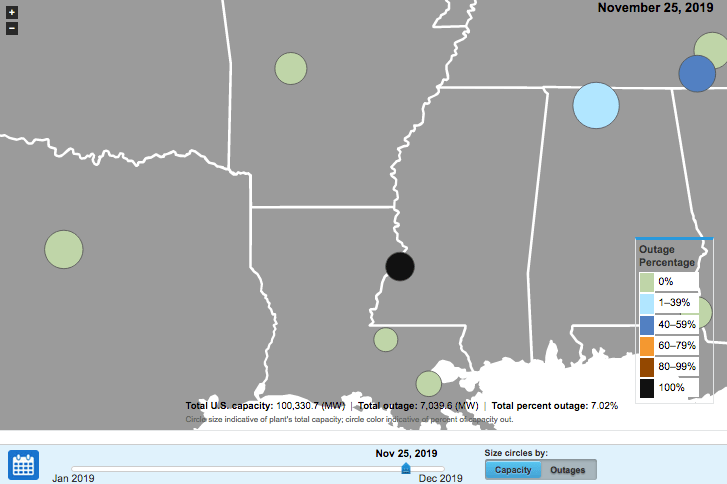Grand Gulf is supposed to run almost every single day at full capacity, acting as a foundational “base load” plant in the region’s energy system. It represents roughly one-fifth of all the generation that Entergy New Orleans owns or has purchase agreements for. But over the last few years, Grand Gulf has been beset by a series of planned and unplanned outages that have made it the least reliable nuclear generator in the US, according to the Nuclear Energy Institute, an industry trade group. In fact, the plant was in the middle of an outage this week. These outages cost New Orleans residents millions of dollars, according to figures Entergy has provided the City Council. From 2016 through 2018, nuclear plants in the US produced about 92 percent of their maximum generating capacity on average, according to the US Energy Information Administration. Over that same period, Grand Gulf produced 55.5 percent of its capacity. During those years, Grand Gulf was only fully functioning 34 percent of the time. It achieved partial outputs for 31 percent of the time, and for the remaining 35 percent it didn’t generate any energy at all. That’s according to a 2018 report from E&E News with updated figures supplied by the Nuclear Regulatory Commission. Things improved in 2019. So far this year, the plant has run at 100 percent capacity 85 percent of the time. But it looks like in 2020, the plant will face another long outage. On a recent earnings call, Entergy Corp. CEO Leo Denault said that the plant would go offline for part of 2020 and that it “will be a long outage.” The Lens sent the company a list of questions to the company about reliability problems at the plant. In response, spokesperson Neal Kirby provided a brief written statement that only addressed the planned 2020 outage, but wrote that he could not reveal how long it will be. “The 2020 outage at Entergy’s Grand Gulf Nuclear Station is planned for refueling and maintenance at the plant,” Kirby wrote in an email. “We time these refueling outages when other generators and market purchases can be available to supply power economically to our customers. It is not appropriate to discuss the timing or length of outages because that is market sensitive business information.” No matter how long it is, the outage could be expensive for New Orleans residents. According to Entergy, outages at Grand Gulf can cost New Orleans customers upwards of $100,000 a day. In a letter to Councilwoman and utility chair Helena Moreno, Entergy New Orleans CEO David Ellis revealed that an eight day outage in December 2018 cost residents $1.15 million. In addition, a three-day outage in September 2018 cost customers $800,000, Michael Goin, director of planning analysis for Entergy Services, Inc., said at a May City Council meeting. A two-day outage in February cost customers $400,000, he continued, while a five day outage that was still occuring on the day of the meeting was costing an estimated $90,000 a day. Those figures represent money that Entergy New Orleans is not making by selling Grand Gulf’s energy on the market, even though it still has to pay operations and maintenance on the plant. But those numbers underestimate the true cost burden because New Orleans customers also have to foot a portion of the bill to repair the plant. According to an Entergy spokesman quoted in E&E News last year, Grand Gulf has hired hundreds of new workers and made $265 million in capital investments in recent years. And the company will make $435 million in additional investments over the next three years, according to an Entergy presentation from two weeks ago. New Orleans customers will have to cover part of that. They will also have to pay Entergy a profit for making those investments. As The Lens has previously reported, the return on investment that utilities are allowed to collect on capital investments can have a huge impact on how much customers have to pay on their monthly bills. The new gas plant in eastern New Orleans, for example, will cost $210 million to build. But according to an analysis by the Alliance for Affordable Energy, customers will also have to pay Entergy a profit bewtween $240 million and $280 million. However, that calculation was done using a 30-year payment timeline. But the council recently approved a 50-year timeline as part of a measure that sets the company’s rates for gas and electricity. After that is taken into account, the Alliance now predicts that Entergy New Orleans will collect a profit of $431 million from its customers. The New Orleans City Council regulates Entergy New Orleans and as regulator, has the right to open so-called “prudence investigations” into the company. It recently completed an investigation into the company’s response, or lack thereof, to frequent blackouts in New Orleans. That resulted in a $1 million fine. But no such investigation has been done on Grand Gulf, said former Entergy executive Chip Estes. “No regulatory entity has ever formally launched a prudence investigation for Grand Gulf, from the time construction began in the 1970’s to the more recent numerous mistakes and practices by Entergy personnel,” Estes told The Lens. Estes worked for Mississippi Power & Light, which would later become Entergy Mississippi, from 1984 to 1991, and for Entergy Services Inc. from 1991 to 1993. More recently, he worked as the southern regional director for the Midcontinent Independent System Operator, which manages the transmission system from Louisiana all the way into Manitoba, Canada. He said that the recent failures demand an investigation into how Entergy has operated the plant in recent years and how much customers are paying. “Entergy Corporation and their shareholders have benefited significantly from an overall lack of proactive regulatory oversight of the Grand Gulf Nuclear Station,” he said in an email. “This lack of proper oversight can be attributed partially to Grand Gulf’s unique status as a multi-state entity that is under both state and federal jurisdiction. … The responsibilities are shared by the City Council of New Orleans, the Arkansas, Mississippi, and Louisiana public service commissions, plus the Federal Energy Regulatory Commission.” “It is obviously a challenge for all entities to align in a joint investigation, but current performance at Grand Gulf demands such an action to be initiated on behalf of ratepayers.” he said. On the recent earnings call, Denault said that next year’s planned outage “will be the final one in terms of getting things back to where they need to be.” Whether that turns out to be true has big implications for New Orleans residents. The energy coming from Grand Gulf is part of the city’s long-term plan. Grand Gulf recently extended its license through 2044. And the city won’t just be relying on the plant to deliver low-cost energy; it will also lean heavily on the plant to help achieve its emissions reduction goals. When Grand Gulf is down, other generators have to step up to take its place. For the most part, those are traditional fossil fuel plants, leading to higher carbon emissions. The bottom lineGrand Gulf is mostly owned by Entergy. One of its subsidiaries called System Energy Resources Inc., or SERI, owns 90 percent of the plant. Mississippi-based Cooperative Energy owns the remaining 10 percent. The 90 percent of generated power allocated to SERI is split between four other Entergy subsidiaries: Entergy New Orleans, Entergy Arkansas, Entergy Mississippi and Entergy Louisiana. Those companies are also responsible for paying for the plant’s operations and maintenance costs, including employee salaries, fuel and insurance. Entergy New Orleans’ share of Grand Gulf cost customers $113 million in 2017, according to filings by Entergy New Orleans. Just because New Orleans has claim over energy produced at Grand Gulf doesn’t mean that the energy will ever actually make it to the city. That’s because our energy system is operated on a regional level. Utilities such as Entergy New Orleans put all of their generating sources on a market run by the Midcontinent Independent System Operator, or MISO. The utilities then buy the energy they need from the market on a daily basis, while selling energy onto the market to offset the cost. So even when the actual voltage produced by Grand Gulf doesn’t reach New Orleans, its output offsets power we buy from other sources that aren’t owned by Entergy. On a customer’s monthly bill, these costs show up in the “fuel adjustment charge.” “If that unit’s not running, then that’s not money coming back to cut the bills in New Orleans,” Goin explained to the council’s utility committee in May. “So its lost revenues that would have come in.” For the eight-day outage in Dec, 2018, Entergy New Orleans lost $1.7 million worth of energy it would have been able to sell on the market. At the same time, the city saved $550,000 on fuel costs for Grand Gulf. Fuel costs are only a fraction of the cost to keep Grand Gulf running, since nuclear plants use very little fuel compared to fossil fuel plants. Entergy New Orleans still has to pay those other costs, even when the plant isn’t producing any energy. Logan Burke, the executive director of the Alliance for Affordable Energy, argues that this becomes even more expensive because of how Grand Gulf’s absence affects the market. “If that plant just goes down as it has been doing, and especially if there’s no warning, it punches what some people call a hole in the market,” she told The Lens. “It’s like all of a sudden there’s a big empty space there and there’s a spike in supply costs… So that means that not only are we having to pay for Grand Gulf, not only are we having to pay for extra power on the market, we’re having to pay a premium on the market because this thing went down unexpectedly.” And then there is the hundreds of millions of dollars it takes to fix the plant, as well as the profit Entergy gains from the repairs. Entergy New Orleans doesn’t own the plant, so it can’t collect a profit on those investments. SERI, on the other hand, is authorized to collect a profit from the four subsidiaries that buy the plant’s energy. And those subsidiaries, including Entergy New Orleans, pay for that profit by charging their customers. “You have a crazy high [return on investment] for this thing that has zero risk because all the costs are automatically passed to the customers,” Burke said. SERI has a much higher return on investment rate than Entergy New Orleans. It’s so high that the public service commissions of Mississippi, Arkansas and Louisiana have all lodged complaints with the Federal Electricity Regulatory Commission claiming that the return on investment rate at Grand Gulf is too high and should be lowered. “In both [2016 and 2017] Grand Gulf presumably had extended outages, but SERI was paid even when it could not supply power,” the original complaint from the Louisiana Public Service Commission said. “In a competitive market, SERI would be a failed company; its continued highly successful survival is due to guarantees provided through regulation.” MICHAEL ISAAC STEINMichael Isaac Stein covers New Orleans' cultural economy and local government for The Lens. Before joining the staff, he freelanced for The Lens as well as The Intercept, CityLab, The New Republic, and... More by Michael Isaac Stein
0 Comments
Leave a Reply. |
Archives
July 2024
Categories
All
|
|
|
If you want to be a frontline soldier on environmental protection, social justice, or environmental racism, come to Louisiana” –Gary Groesch, Founder of AAE
|
View our events calendar for important upcoming community events and public meetings!
|
|
Copyright © 2022 · Alliance for Affordable Energy



 RSS Feed
RSS Feed